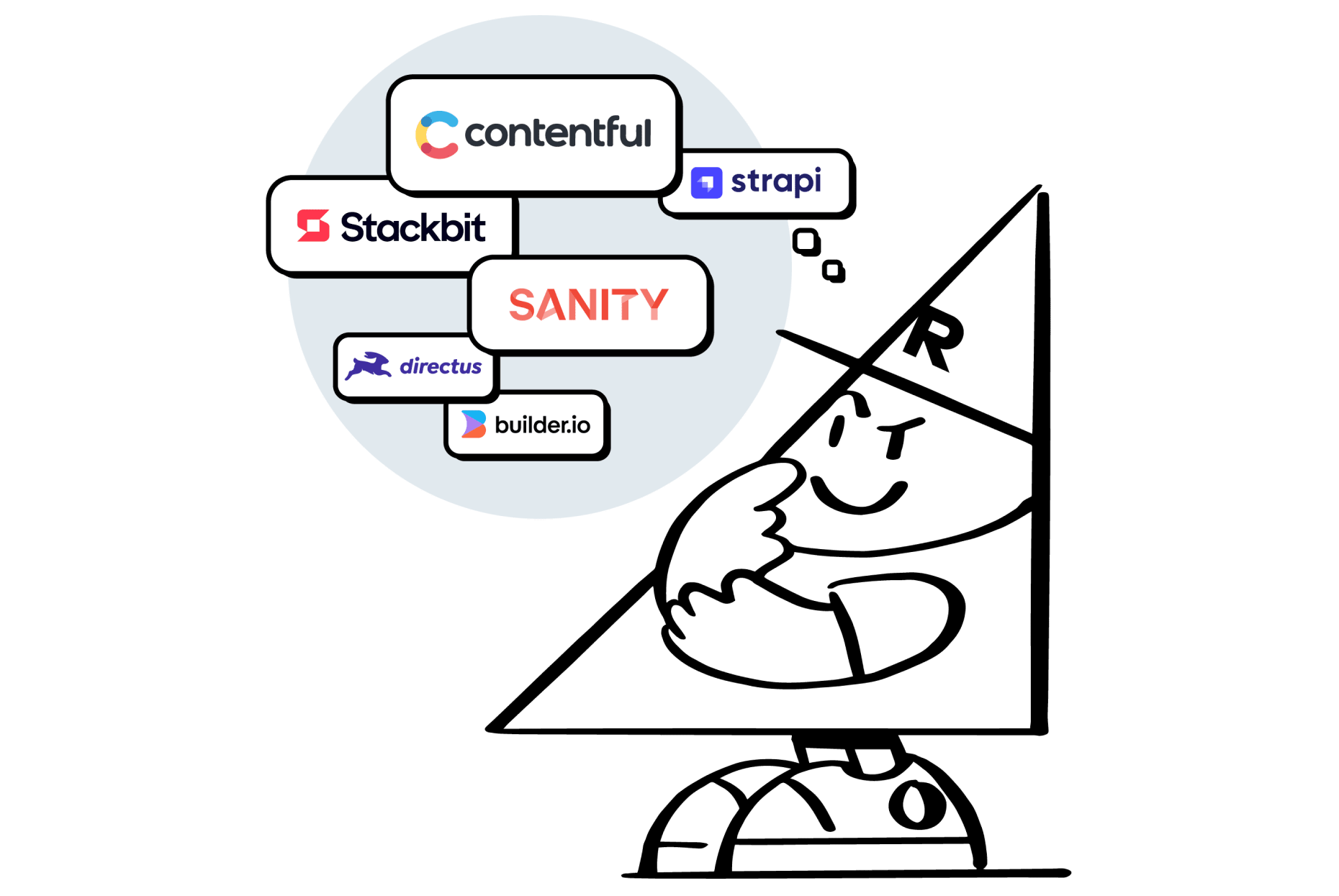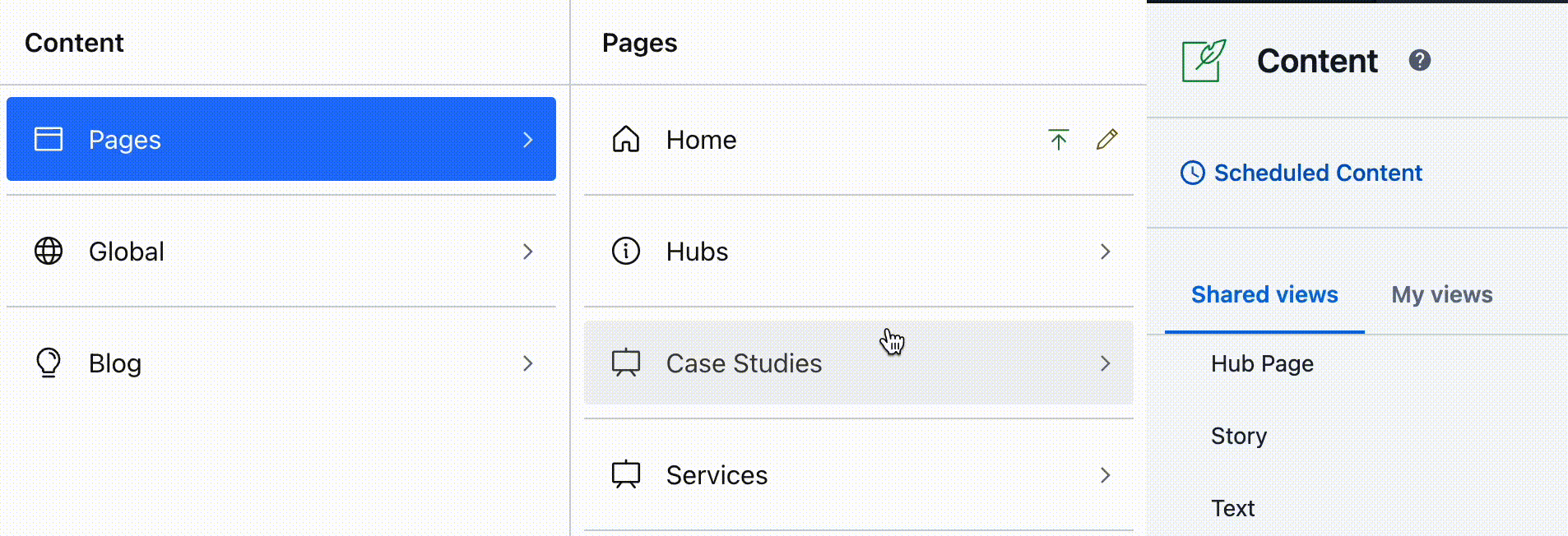Best Headless CMS Platforms in 2023
Contentful, Sanity, and Strapi are the headless CMS platforms we recommend most often to our clients. Here's a comparison of features that matter, plus an in-depth guide to choosing the right headless CMS platform for you.

Best Headless CMS Platforms in 2023
Contentful, Sanity, and Strapi are the headless CMS platforms we recommend most often to our clients. Here's a comparison of features that matter, plus an in-depth guide to choosing the right headless CMS platform for you.
| Feature | Contentful | Sanity | Strapi |
|---|---|---|---|
| Pricing | 💰💰💰 | 💰💰 | 💰 |
| Customizability | ✅ | Best-in-class | ✅ |
| Dedicated customer support | Best-in-class | Enterprise only | Enterprise only |
| SOC 2 compliance | Yes - Type 2 | Yes - Type 1 | ❌ |
| Self-hosting of CMS data | ❌ | ❌ | ✅ |
| Unopinionated content model | ✅ | ✅ | ❌ |
| Learning curve | Steep | Steep | Low |
| Multi-language & localization | ✅ | ❌ | ❌ |
| Role-based permissioning | Best-in-class | Limited | ✅ |
| - User activity audit log | ✅ | ❌ | In beta |
| - Visual interface for access control | ✅ | ❌ | ✅ |
| Authentication | ✅ | Limited | ✅ |
| - Single-sign on (SSO) | SAML 2.0 | Manual configuration | Passport.js |
| GUI for content modelling | ✅ | ❌ | ✅ |
| Digital asset management (DAM) | ✅ | ✅ | ❌ |
| Rich-text editor | Limited | ✅ | Limited |
| WYSIWYG editor | ❌ | ❌ | ❌ |
| Open-source | ❌ | ✅ | ✅ |
| Third-party plugins/extensions | Extensive | Extensive | ✅ |
| - UI enhancements | Limited | ✅ | ✅ |
| - E-commerce | ✅ | ✅ | Limited |
🏆 Best for enterprise: Contentful
Regulatory & compliance
SOC 2 compliance is a must-have for most finance and healthcare companies. Contentful is the only SOC 2 Type 2 compliant headless CMS. Sanity has recently achieved SOC 2 Type 1 compliance, but not Type 2.
Service Organization Control (SOC) 2 is a compliance standard that outlines best practices for how companies secure customer data. It covers processes such as encryption, backup, and protection of customer data from unauthorized access; incident response and timely vulnerability management; and hiring, on-boarding, off-boarding, and anything related to employee access to data and managing permissions.
SOC 2 Type 1 compliance is important for organizations that need to demonstrate that they have implemented effective controls over their systems and processes, while SOC 2 Type 2 compliance is important for organizations that need to demonstrate that their controls not only exist but also operate effectively over a period of time.
Contentful is the oldest, most mature headless CMS and, in our experience, more familiar than other CMSes with regulatory and legal requirements, audits, and processes and helping stakeholders get approval for using their platform across multiple levels.
Enterprise support & features
For enterprise organizations with hundreds or thousands of employees, Contentful is our go-to choice.
Contentful has the most experience supporting enterprise clients, and the largest customer support employee roster. While all three CMSes offer technical support with service-level agreements (SLAs), Contentful offers extensive dedicated customer support, including developers and solution architects, as well as professional service offerings.
Companies with many brands and bigger teams have more complex workflows, and Contentful offers more features to handle scaled workflows. For example, a large organization with multiple content teams working on different parts of a website need granular user access control, audit logs, and a visual interface for user management.
They may have authors who should only edit SEO or analytics-related content, and nothing else. Enterprise organizations also likely need single sign-on (SSO) to grant and revoke access to on-boarding and off-boarding team members, especially if they’re paying per seat.
Smaller teams and organizations may prefer Sanity and Strapi’s developer-driven community support. Like with React, there’s a lot of passionate people writing blogs and content about Sanity and Strapi (and other open-source CMSes) that is not officially supported by the respective CMS.
Multi-language & localization
Contentful offers built-in support for multi-language and localization. It allows developers to easily create and manage content in multiple languages and locales, including support for translations, fallback languages, and language-specific fields. It also offers a built-in user interface for managing and previewing translations, making it easy for content editors to manage multi-language content.
Sanity and Strapi allow for multiple languages and locales, but do not have built-in functionality, and developers will need to build a custom solution or integrate with third-party plug-ins to provide localization.
🏆 Most customizable: Sanity
User experience & content modelling
Developers can customize content models to mirror the needs of a client’s business. For example, an e-commerce brand’s main content may be product pages; however, a consulting agency’s main content may be blog articles or case studies.
In Sanity, we can also add custom input fields and widgets and customize how users interact with and navigate the platform. For example, if a user is editing a blog, they don’t need to see all the other components and content entries that are irrelevant to blogs. You can set up a custom navigation to hierarchically organize your content model.

In Contentful, users select the content type and see everything that’s there, as a long, unstructured list of content types, which makes it more difficult to find what they’re looking for. This is in part because Contentful offers a GUI for content modelling; the cost of having an easy-to-use GUI is less flexibility in customizing the UI.

You can also create a custom nav bar so that an author editing the hero editorial on the home page doesn’t have to see all the other content on the page.
Rich text editor (RTE)
Sanity also has the most extensible, easy to use, and robust rich text editor we’ve seen out of all the headless CMSes. It returns rich text content as Portable Text, which can be used in pretty much any format or markup where you want to render rich text content. You render Portable Text by serializing the arrays that contain your content into the format you need it. There is tooling for generic markup and programming languages and for popular frameworks, making it easier to serialize Portable Text and lets you decide how custom content types should be handled.
Another highly customizable RTE we like is Directus’s RTE, which is based on TinyMCE. Contentful’s rich text editor is proprietary and doesn’t allow you to add custom components.
CMS data querying
Sanity is the only headless CMS with their own querying language: GROQ.
Sanity, Contentful, and Strapi all support REST and GraphQL APIs. With REST, whatever endpoints are made available by whoever wrote the API dictate what you can query. GraphQL offers more flexibility because you can dictate what shape of data you want returned, but if you don’t know the shape, it will return an empty object.
With GROQ, you can return everything. For example, when you pick components on a page, you have to pick them ahead of time to use with GraphQL; with GROQ, you can tell it to return whatever’s there or you can specifically query the shape of data you want. The ability to return everything is powerful because CMS data is dynamic, and GROQ offers you the flexibility of querying data you want without having to hard code anything at the beginning.
🏆 Self-hosted: Strapi
Self-hosting of CMS data
Strapi is one of few CMSes that allow you to host your own data.
Organizations with sensitive data, or strict security or compliance requirements, may need to fully own and control their CMS data and infrastructure.
We recently chose Strapi to build a simple website for a client in a highly regulated industry because getting approval to host data on an external server would take weeks to months (or be rejected).
Those with in-house IT teams, hardware, and network infrastructure may also find self-hosting more cost-effective compared to cloud-based services.
Easy to get started
Strapi is simpler to set up than Sanity and Contentful. Developers and teams without much headless CMS experience may prefer Strapi to Sanity or Contentful.
The key advantage of a headless platform is flexibility, but starting from scratch is difficult. Strapi provides a middle ground.
Strapi’s opinionated content model is designed to provide a ready-made structure for storing and managing content, making it easier for teams to get started. They define standard fields and relationships between content types, allowing teams to focus on creating and managing their content without having to architect their own content model.
However, the architecture they offer may not work for custom or complex builds.
Pricing
Strapi’s paid plans start at $9 per month; Sanity’s start at $99 per month, and Contentful’s start at $300 per month (updated in April 2023). We’ve also found Strapi and Sanity’s free plans to be very generous and great for small teams getting started.
🌟 Honourable mentions
Directus
Directus is a popular choice for organizations that are looking for an open-source, self-hosted CMS. Unlike Strapi, Directus offers an unopinionated content model. Directus also has built-in SSO (SAML 2.0) and robust role-based permissioning features. However, as a relatively new CMS, they lack some features and capabilities that Sanity and Strapi currently offer (e.g., auto-save, third-party plug-ins and extensions).
Builder
Builder is the only headless CMS with a built-in What You See Is What You Get (WYSIWYG) editor. The WYSIWYG editor allows users to create and manage content visually, without having to write code, making it easier for non-technical users to change the website. Content authors can drag and drop pages and components without a developer.
They’re also relatively new and lack many features that other CMSes currently offer, but experienced and inexperienced teams alike will love its modern, user-friendly interface.
Stackbit
Stackbit provides a WYSIWYG editor that works with Sanity, Contentful, and any other CMS without slowing down your website. If you're looking for a self-hosted option with a stellar visual editor, we recommend using Stackbit with its own git-based CMS or with Strapi.
Because Stackbit is framework agnostic, it’s a powerful tool for website migrations. With Stackbit bridging the old and new CMSes, teams can migrate pieces of a platform while authors continue managing and editing content on Stackbit. This also means Stackbit is the last platform content authors will need to learn.
Summary
Sanity, Contentful, and Strapi are the headless CMS platforms we recommend most often to our clients.
For most retail e-commerce clients, we use Sanity because it’s flexible and developers and content teams alike love the experience.
Contentful is our go-to platform for clients in financial or healthcare services, and large enterprises with complex workflows or need SOC 2 compliance.
We recommend teams that need to self-host or need a relatively simple website to take advantage of Strapi’s easy to use platform and built-in content models.
Want more? We’re launching a new podcast + blog series about headless CMS. Check out our headless hub and subscribe to get our latest updates fresh off the press.